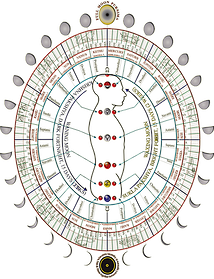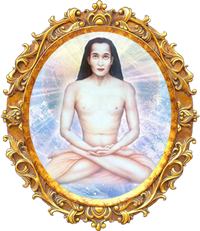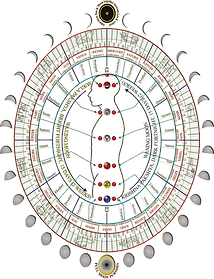

|
|
|||
|
|
|||
|
|
|||
|
|

|
|
||
|
|
||
|
|
||
|
|



|
|
|||
|
|
|||
|
|
|||
|
|

|
|
||
|
|
||
|
|
||
|
|

Human life progresses 360 times slower than the solar movement. One solar day is divided into 360 human days (days on Earth) and the Earth is the foundation of the human body. This is why human life and the mind are regulated and guided by the natural cycles of the Earth such as the months and seasons. The totality of human life is a mixture of four things: body is the earth; mind is the Moon; life and true knowledge (vidya) are the Sun and breath is the ascendant. Life descended to the physical level and is affected (sufferings and enjoyments) by mental and physical forces according to the cycles of the Moon (27 days=one cycle of the zodiac) and the Earth (360 days=one cycle of the zodiac). The Moon cycle is 27 sidereal (star calculation) days (naksatrika-divasa) and the Earth cycle is 365 (or about 360) Earth days.
Below we can see how time and the body are harmonized with each other.
The scriptures state that body movements can be used to calculate time. Of the many physical movements (of hands, legs, mouth, head, neck etc.) the blinking of the eyes is used for calculating time:
Now let us compare human prana (iswara) with time. According to the Yoga Sutras of Patanjali and other texts such as Siva Purana, present time is called samaya. Samaya is controlled by kala; kala is controlled by mahakala and the lord of mahakala is iswara. It is said that by the practice of ‘iswara pranidhana’ one can go beyond time (samaya), beyond kala and beyond mahakala. How this is practically possible is explained below. This has also already been explained by many Kriya masters like Lahiri Baba, Sri Yukteswarjee and Paramahansa Yogananda.
We have already described how time is calculated, starting from the human action of blinking the eyes, up to Earth time and solar time. Solar time is the primary, naval, middle or balance point (mukhya nabhi) from where plus (+) and minus (-) has been calculated. This is why the axis point of Aries is the highest point of the Sun. The other axis point is Libra, at the lowest point of the Sun.
Human life progresses at a slower pace than solar time, as has already been described. However by iswara-pranidhana one can go from Earth time to solar time – this human life can increase to the same speed of time as the Sun’s time. For example if two competitors are running and the one behind is able to accelerate his speed by more than the one in the front, then it is not only possible for the one who is behind to catch up with the one in front, but also for him to get ahead of the one in front. In the same manner, the Kriyaban, by the practice of Kriya, can move from the material time level to the human time level, then from this level to the rational level and finally to the divine level. There are many other levels above the divine level.
This sequence runs as follows:
The Solar movement is one year. Lunar movement is 27 days. Lagna movement (movement of the breath of life) is one day. Now the question is at what speed does the Kriya Yogi meditate. One can always multiply the years and days and progress to pitrloka and from there to devaloka, then to visnuloka, followed by brahmaloka and finally to iswaraloka but in Kriya the practitioner can go to the highest achievement directly in one breath. It is said in the Bhagavat Gita:
“A yogi can go, by meditation, to the future not only days, years and yugas but thousands of yugas into the future”.
The majority of humanity fails to understand how much potential is held within the human body and life. Due to our ignorance we live in darkness, pain and pleasure.
It is very difficult to describe everything regarding these astrological calculations but this brief description should give the reader a general idea. To understand these concepts one should read “The Holy Science” by Sri Yukteswarjee.
One key point relates to the clockwise movement of Rahu and the anti-clockwise movement of Jupiter. The conjunctions of Jupiter and Rahu in zero degrees Aquarius (kumba rasi) and zero degrees of Leo (singha rasi) are the key to understanding the perfect and clear calculation of the Yugas. When this coincides with the solar eclipse it marks the beginning of a new yuga (era).
In the past the beginning of the various yugas has been marked as follows:
Some astrologers use different and incorrect ayanamsa points based on the upper or lower points between dakshinayana and uttarayana (end of karkata-rasi and beginning of simha rasi). However these should have been correlated with a solar eclipse in order to fix the starting point of a new yuga correctly.
That is why in India, the conjunction between solar-lunar eclipse, Jupiter and Rahu is used to time key events such as the kumbha-mela (in geographically different places: Mumbai, Nasik, Haridwar, Allahabad and Ujjain). The location and time is selected as per the longitude and the time when Jupiter crosses into ajna chakra, i.e. in singha rasi. Some examples include the makara-mela in Ganga Sagar and the Ujjaini-kumbha-mela in Ujjain.
The Jupiter and Rahu conjunction happens in simha rasi very rarely. At a minimum it takes 36 years, whereas the Jupiter/Rahu/Solar Eclipse conjunction in simha rasi takes a few thousand years.
Anyone reading this section about the Kriya calculations will have many questions. To understand more, it is better to just practice more Kriya.
By this way of practice, the human being can go beyond time (samaya), kala and mahakala. The scriptures say that time lags behind and prana moves ahead since normal human life takes 360 days to reach the same point in solar time. By accelerating with Kriya prana, life (iswara) moves ahead while solar movement is relatively fixed since it is a planetary movement. It is never possible for solar and stellar systems to catch up with iswara. In this way a human being can reach Samadhi and the ultimate goal, hiranyagarbha which is the finality of all calculations and tapasya and which exists only in the human body.
Ascendant |
Represents our pranavayu or the breath of life, the inhalation, I myself, the deathless child |
4th House |
Represents mother, the Moon, the body and one’s physical origin (yoni – the womb). |
7th House |
Represents exhalation. If the ascendant is life, then this side is death. Similarly, if the ascendant is the rising sun, the light, this side is the setting sun, the darkness. The ascendant is day and the descendant is night. |
10th House |
Represents our previous karma, our present karma, physical actions and spiritual actions. |
Table: Different Parts of the Horoscope Corresponding to a Human’s Life
Four different parts of the horoscope that correlate to the key parts of our life are the ascendant, the fourth house (mother’s place), the seventh house (place of spouse and death) and the tenth house (father’s place).
It is also said in the scriptures that one purusa visesa iswara Kriya can cross the whole cycle of yugas which is 24,000 years. So it really all depends on the practitioner to develop a disciplined practice of Kriya and thereby and understanding of this.